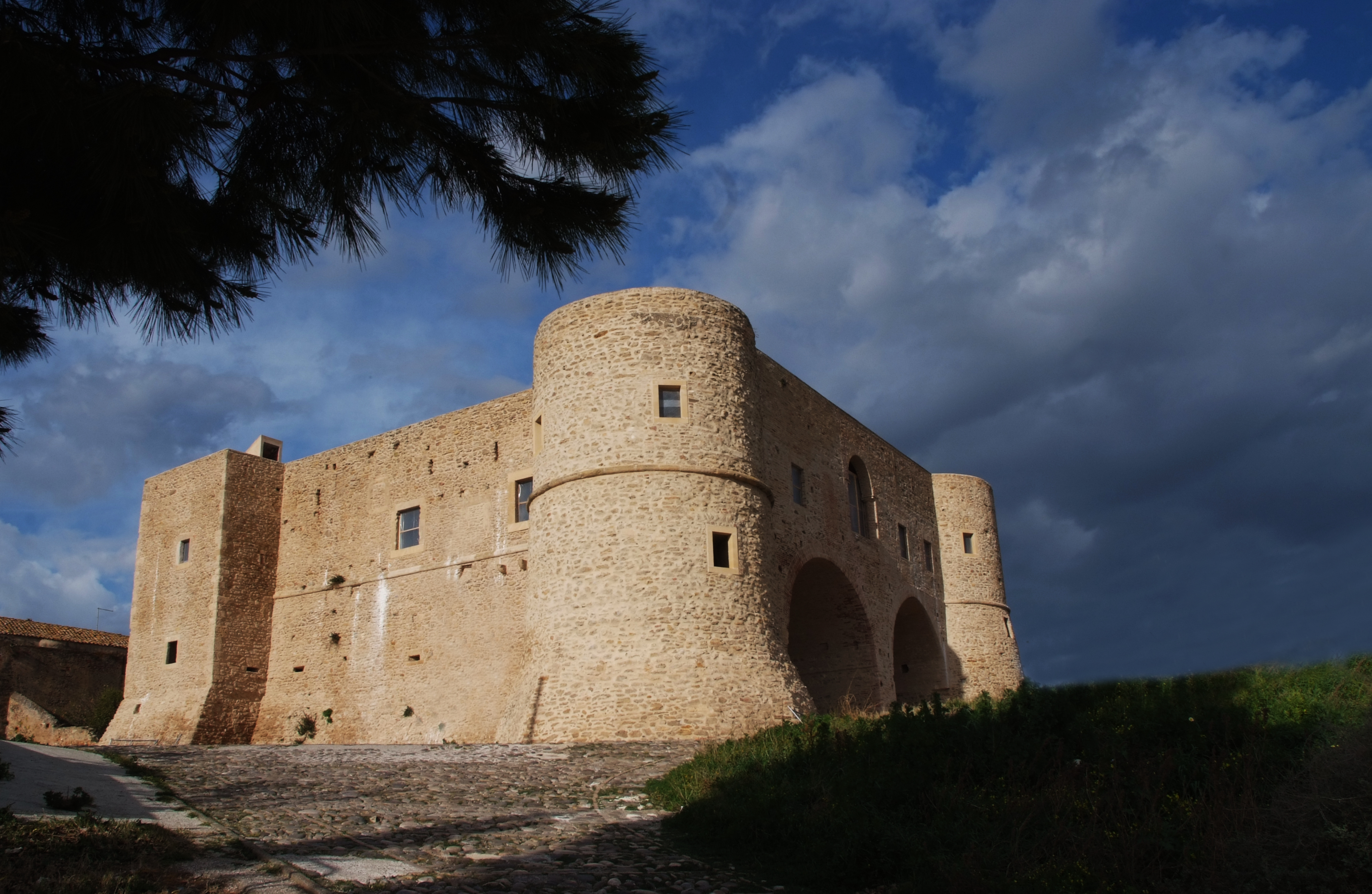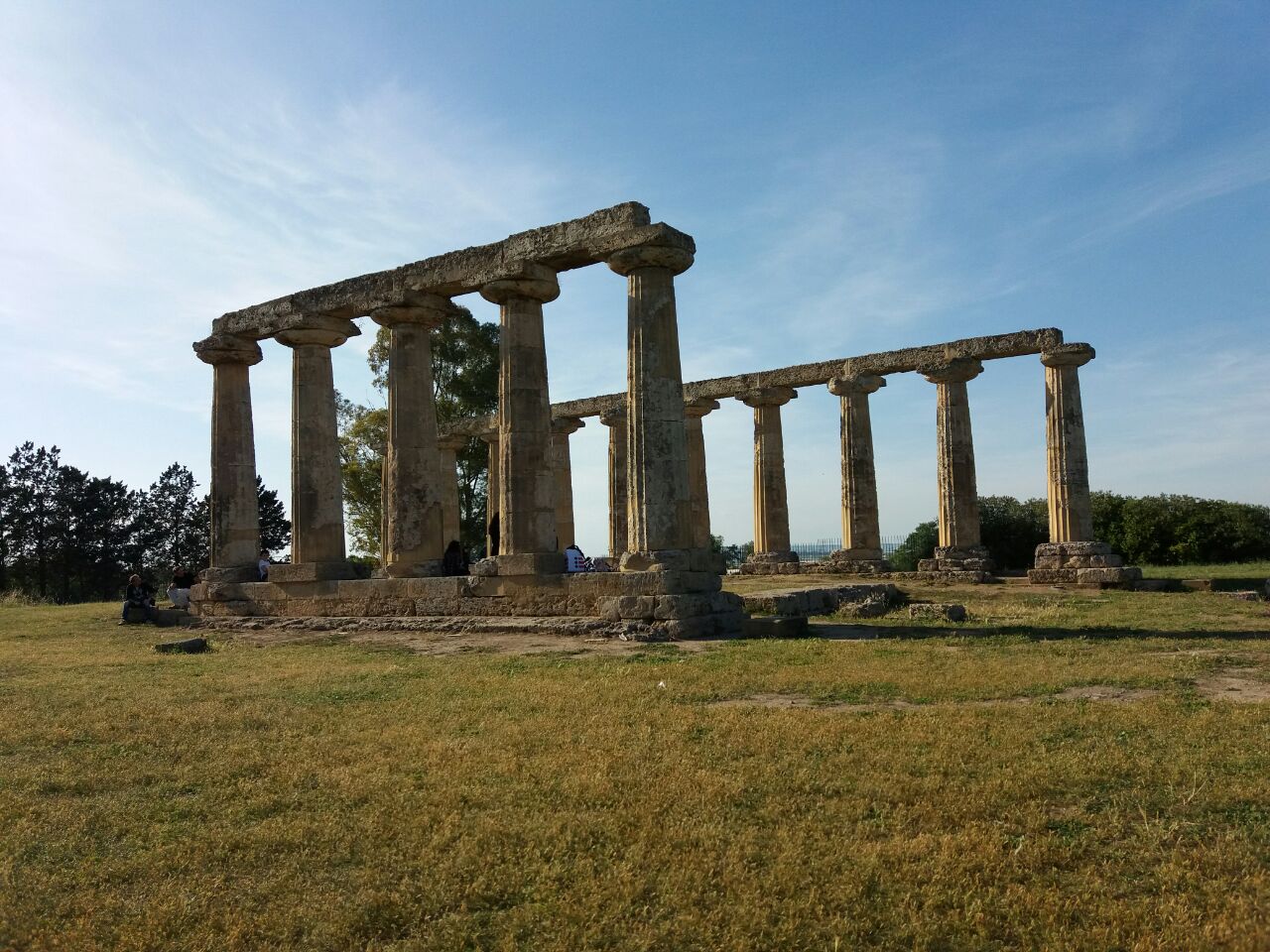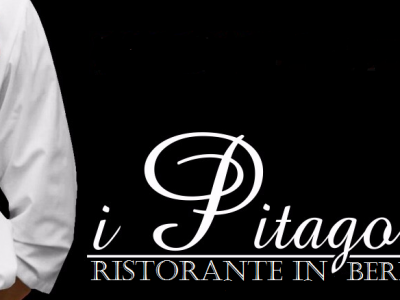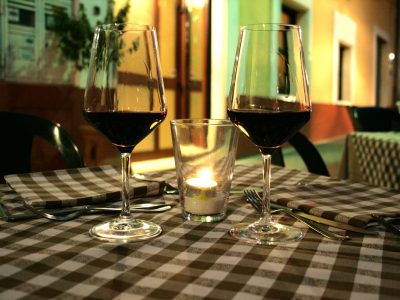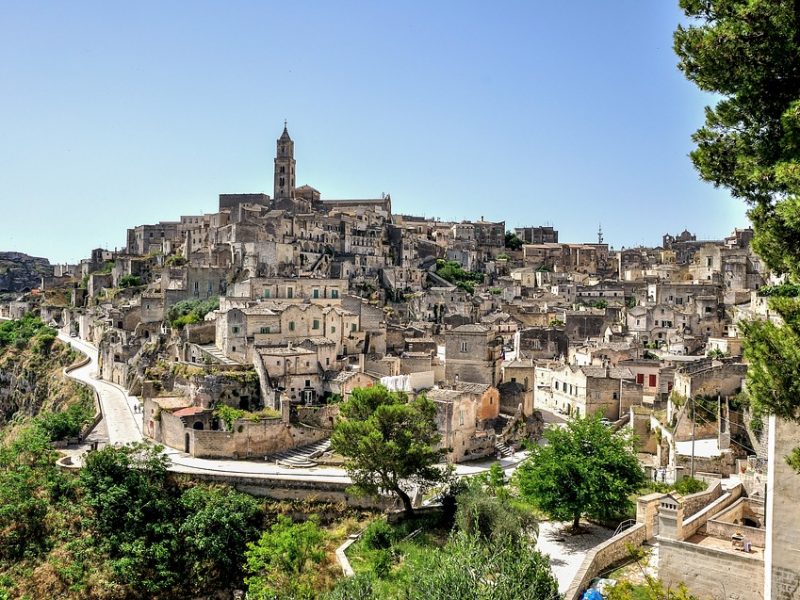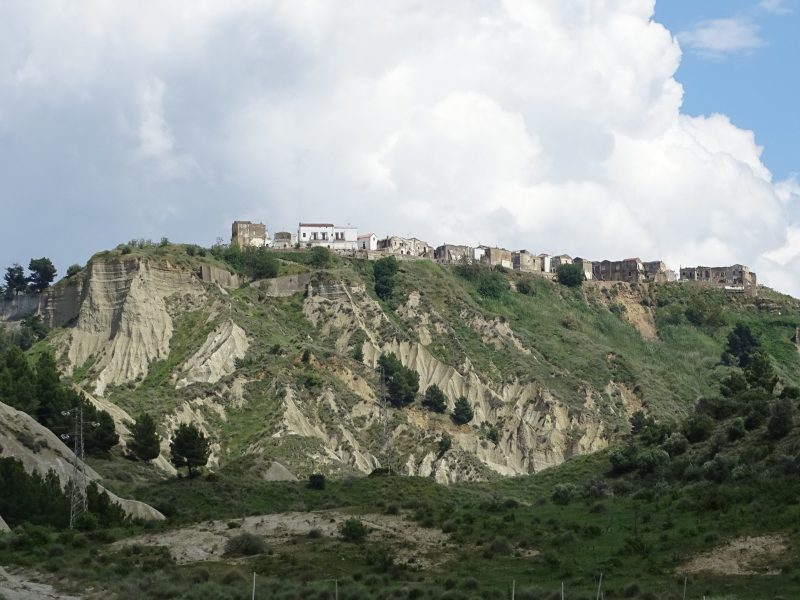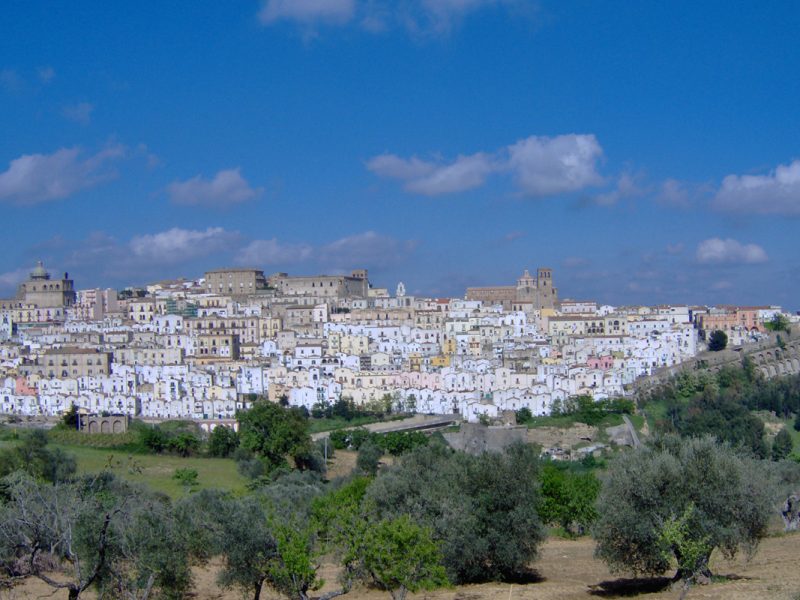The Borgo of Bernalda
The gates of Basilicata swing open to reveal tiny villages glittering like jewels in the heights of the Calanchi hills, and among them all, the most precious gem is Bernalda.
The journey through the wonders of this village begins at the Piazza del Plebiscito, with the mother church and the statue of San Bernardino da Siena. A little further on, we find the splendid Aragonese Castle, its sculpted ochre walls looking out over the infinite Metaponto plain.
The modern city walls overlooking pungent Mediterranean foliage and fig trees will be our guide through the historical center of Bernalda: ancient stone streets that exude a heady mix of spirituality and local traditions, with tiny churches everywhere and exquisite votive shrines adorning every corner.
The historical center of Bernalda is the custodian of all the small and charming details that make villages in Southern Italy so beautiful. The streets are a mosaic of simple homes and regal palaces with imposing balconies, here and there garlands of red peppers glow in contrast with the stark purity of whitewashed walls. The laughter of the children rings down the hills, while the scent of fried vegetables for Sunday lunch wafts through the air. Doors are flung open to reveal tables laden with steaming delicacies and families in animated conversation, their voices spilling joyously out into the streets.
Bernalda also enjoys dressing up and showing off an elegant, worldly side. Take a stroll down Corso Umberto I to savor a freshly-made ice cream, stop for a delicious aperitif, or just relax and enjoy the summer evening, sipping a refreshing cocktail as you watch the world go by.
This little borgo in Basilicata has absolutely everything, and even the stars of Hollywood feel at home here, crossing the Atlantic to be Francis Ford Coppola’s guests in his magnificent historic hotel, Palazzo Margherita.
Bernalda stands proud on a hill overlooking the Metaponto plain, in a strip of land wedged between the Basento and Bradono rivers.
Its origins date back to the arrival of a community of Greek settlers in Basilicata, but it was upon the arrival of the Dori population in 207 B.C. that the first urban center was established, called Camarda. Camarda was an agricultural complex, and for this reason enjoyed a certain autonomy, inhabited for the most part by settlers and shepherds, and administered by powerful local lords.
A remarkably serene history, until 1378, when a violent earthquake completely destroyed the borgo, which was then slowly brought back to life with the arrival of the Aragons. In the 1500’s, King Alfonso II of Aragon assigned this fief to his secretary, Bernardino de Bernardo, who ordered the construction of a castle on the same spot as a Norman tower, which was incorporated into the new structure. Bernardo then focused on protecting the borgo, surrounding it with a defensive wall, complete with watchtowers placed at intervals around the circumference, and imposing a grid-like plan on the historical center. The mother church was also constructed in the fifteenth century, called the “convent church”, dedicated to San Bernardino da Siena, the patron saint of the borgo.
Over time, Camarda became Bernuda, and then Bernaudi Terra, finally settling on the name Bernalda.
In the 1700’s, a wave of construction projects brought about the creation of the new town, built between Porta Maggiore and the convent of Sant’Antonio.
The modern history of this borgo in Basilicata is marked by conflict, often violent, due to territorial disputes over the land and woods between Bernalda, Montescaglioso and Pisticci. These territorial clashes finally came to an end in 1978, when the land was definitively assigned to the farmers.
In the 1800’s, poor sanitary conditions in the borgo caused numerous epidemics, in particular a cholera epidemic, which according to popular belief, ended thanks to the intercession of San Bernardino. At the end of the century, the economic crisis led many of the families in Bernalda to emigrate to America, following the wake of the mass emigration taking place throughout Southern Italy.
In 1932, the attractive coastal area of Metaponto was extracted from the jurisdictions of Montescaglioso and Pisticci, and assigned to Bernalda. In this same period, the acting Fascist regime implemented projects to drain the malaria-infested swamp areas.
The second half of the twentieth century was characterized by a second migratory flow, this time towards northern Italy, Germany and Switzerland. Regardless of this trend, even those who decided to remain in Bernalda were able to find employment fairly easily, thanks to the many factories that were opened in the Basento valley during that period.
Metaponto
In 1932, Metaponto became a hamlet of Bernalda. Basilicata is full of dramatic, breathtaking landscapes, characterized barren stretches of land, expanses of Mediterranean vegetation, imposing mountains, and the clay-rich hills of the Calanchi, but it surely cannot be defined as a land of the sea. The only famous sea-side area on the Ionian sea is Metaponto.
Metaponto is characterized by wide, sandy beaches, summer resorts and a crystalline sea perfect for water sports and sailing, while the areas near the mouths of the Basanto and Bradano rivers offer excellent sport fishing.
Metaponto is not only a sea-side holiday location, it is also rich in history and culture.
Metaponto was founded in the seventh century B.C. by Greek colonists, in a portion of territory that today is known as “Magna Grecia”. During this period, Metaponto developed dramatically, becoming one of the most important Greek colonies in Southern Italy, thanks to the fertile land that guaranteed a flourishing production of grain and wheat.
The initial period of Roman domination coincided with the beginning of a long decline for the territory, accentuated by the continual flooding of the rivers, which led to the depopulation of the inhabited center.
Today, Metaponto is also renowned for its important archeological park.
The Archeological Park of Metaponto
The Archeological Park of Metaponto is one of the most evocative and fascinating places in Basilicata, creating the impression of having traveled back in time, to immerse yourself in the glorious culture of Ancient Greece.
You can almost hear the passionate speeches and dissertations given in the polis, which took place in the agòra, and then move on to explore what remains of the sacred area dedicated to worship and sacrifice. Two large columns mark the presence of the ‘Tavole Palatine’ temple. This temple dates back to the sixth century B.C. and was dedicated to Hera, protector of borders, and was built near a sacred spring. Today, you can admire the two rows of columns, twelve on one side and six on the other, all in Doric style.
Although it is the only temple remaining with its columns intact, the Tavole Palatine temple is not the only one present in the area, in fact, the ruins of other temples have been discovered nearby. There is a temple dedicated to Athena, dating back to the sixth century B.C., a temple dedicated to Apollo dating back to 570 B.C., and finally, what must have been the most magnificent of all, the temple dedicated to Aphrodite, built in 470 B.C.
The ancient Greek polis was enclosed by city walls dating back to the sixth century B.C. and subsequently remodeled in the fourth century B.C, as can be distinguished by the addition of various monumental entrances.
Recent archaeological finds have also brought to light the ruins of some ancient farms outside walls, testament to further urban expansion in that period.
The Aragon Castle of Bernalda
The Castle of Bernalda stands on a strategic point overlooking the Basento valley, the ideal place for the construction of a fortress.
The presence of a square tower dating back to the Norman period is evidence of a previous defensive construction that had probably been heavily damaged by the continual earthquakes that struck the territory. For this reason, a complete reconstruction of the fortress was deemed necessary during the Aragon period.
The castle was commissioned by Bernaudo de Bernardi, secretary to Alfonso II of Aragon. The original structure was built in a quadrangular plan, with four cylindrical corner towers, the only Norman elements included in the reconstruction. Continual remodeling interventions reduced the structure, in fact, today only three towers are present.
It is probable that at the time the castle was constructed, there was an ever-present threat of siege looming over the town. For this reason, Bernardi had fourteen wells built inside the castle to ensure a water supply in the event of attack. In case the walls were breached, an escape route was created by excavating underground tunnels, some of them extremely long, such as the one leading all the way to the Basento valley.
Today, some of the halls in the Aragon Castle host the Municipal Art Gallery.
The Main Church
The main Church in Bernalda was built in 1530 at the behest of the feudal lord, Duke de Bernaudo, in dedication to San Bernardino da Sienna.
Although it has undergone many alterations over the centuries, it has always maintained its sober and essential style.
Historical documentation reveals that the church originally had a single nave, with three alters and the side naves added at a later date. The right nave was built over the previous sacristy, while the left nave was built in the eighteenth century.
From an inventory of the Bishop of Matera dating back to the eighteenth century, it is possible to obtain an idea of the church at that time: it must have had eight alters and seven chapels, as well as a high bell tower with two bells. In the Age of Enlightenment, the main church safeguarded the tunic of San Bernardino, several holy relics of San Donato and the bones of San Fausto and San Vito. Outside, it had two cemeteries, one reserved for priests, and the other for baptized children under the age of seven.
In the nineteenth century, remodeling and enlargement interventions radically transformed the building into the existing church that we can admire today.
The Church of Madonna del Carmine
The Church of Madonna del Carmine dates back to the sixteenth century and was built in the Baroque style, in compliance with the dictates imposed by Catholic counter-reforms. The original church was smaller than the one we see today, with only one altar, which was adorned with a painting of the Santa Vergine del Carmelo, which was destroyed when the church was remodeled for the first time.
A historical document dated 1726 attests that people were buried in the church, with the stipulation that they were brought into the building six hours after death and buried/entombed twelve hours later.
In the second half of the 1800’s, the church underwent further remodeling and restoration interventions. The crypt of the main altar was dug, four more altars were created and a two story bell tower was constructed.
The Legends of Palazzo Ammicc
The ornate balconies of splendid noble homes overlook the streets of the historical center. One of these is the imposing Palazzo Ammicc, still inhabited today. This fortress-like noble home was probably named for the families that lived here in the past, and owes its fame to the many legends surrounding it.
It is said that this palace once belonged to an extremely wealthy family, who lived here and shared it with other families. On the ground floor there was an atrium where their children played and the farmers often sold their crops. In return, the owner asked only that they work his land.
Before he died, it is said that the nobleman hid all of his gold in the palace, and that the most important treasure was a solid gold, life-size hen and her thirteen chicks. Some claimed that in order to find the treasure, it was necessary to sacrifice an unbaptized male child, but as no one has ever found the treasure, hopefully that was never carried out.
It is also said that the families in the palace are destined to have, for the most part, only female daughters, in fact a popular saying in local dialect is “Palazzo Ammicc femmn assje uommn picc” (Palazzo Ammicc, females many, males few).
Another legend tells of a noble dame who lived in the palace with her three children, two boys and a girl. Being well-off, the noblewoman employed the services of various women in the village, who worked as housekeepers and ladies-in-waiting, helping her to dress and to do her hair.
One day a gypsy who was camping in the Valley of Basento passed through town. Hearing about the legend of the treasure, she slipped into the palace with the excuse of styling the noblewoman’s hair. While she was there, she saw the noblewoman’s daughter, and decided to kidnap her, taking her far away, so that she would forget her origins.
For years, the girl’s mother and brothers waited in vain for her return. Long years passed, and only when the girl had grown to be a women did the gypsies return to camp on the slopes of the village. As she was walking through the streets of the town, the woman heard the toll of church bells ringing in mourning, and sensed that someone important must have died. Returning to the gypsy camp, she began insistently asking the gypsies if they knew anything, and finally, cornered, they confessed that the woman who had died was none other than her mother, explaining the truth about her origins. The woman was so consumed with grief that the gypsies allowed her to participate in the her mother’s wake, as long as she swore to return to them.
Upon seeing her mother, the woman began to cry incessantly, but none of the other mourners knew who she was, until she pronounced the words “Signura mia signura, tu jer a pampn e ii jer l’uv, dnar n’ tniev senz misur ma nun ma saput ammuntuà la mia vntur“ – ‘Signora my signora, you were the vine and I was the grape, money you had without measure, yet you could not guess my sad adventure.’
When the mourning family heard these words, they understood immediately that she was their missing sister, and they begged her to stay with them. But in order not to betray the vow she had made to the gypsies, the woman was forced to escape. As she was fleeing, one of her brothers, overcome with desperation, followed her and shot her down, in a tragic gesture of love to free her forever from the clutches of those who had stolen her away.
Still today, there is a window in the palace that has been walled up, and they say that the spirit of the noblewoman is still there, waiting in eternity for her daughter’s return.
Bernalda, Palazzo Margherita and the stars
At the end of the 1800’s, Agostino Coppola was a young man in Basilicata who joined the mass exodus from his homeland to America.
In the 1900’s, Don Giuseppe Margherita was the mayor of Bernalda. Passionate about Botany, he transformed his love into a spectacular botanical garden around his home, filling it with rare varieties of flora. It is also thanks to Don Giuseppe that we have the magnificent palm trees lining the main street of Bernalda, which have led it to be known as “the most beautiful street in the region.”
The destinies of these two men symbolically crossed a century after their existence, when Agostino’s nephew, the famous American filmmaker, Francis Ford Coppola, decided to buy Palazzo Margherita and transform it into a luxury hotel.
Over the years, Palazzo Margherita has hosted many Hollywood stars. In 2011, the entire city of Bernalda participated in the marriage of his filmmaker daughter, Sofia Ford Coppola, to Thomas Mars, singer in the band Phoenix.
The newlyweds hailed the crowds from the balcony of the palazzo as if they were royalty, and the crowds below erupted in wild joy. Still today, the city cherishes the memory of that famous day.
Francis and Sofia Ford Coppola
Francis Ford Coppola was born in Detroit in 1939. His grandfather Agostino was originally from Bernalda, and like many of his fellow citizens, he left Basilicata at the end of the 1800’s, headed for new horizons and the hope of a better life in America.
Francis Ford Coppola is one of the undisputed titans of American cinema. He has given us ‘The Godfather’, ‘The Godfather 2’, ‘The Godfather 3’, ‘Apocolypse Now’ and long list of other blockbuster hits. His work has placed him in the ranks of the greatest filmmakers in the world, and has been honored with numerous awards, including six Oscars.
He is married to Eleonor and they have three children, Giancarlo, Roman and Sofia.
Although all three of his children work in the film industry, only his daughter Sofia has achieved fame as a director.
Sofia Coppola was born in 1971 in New York. In 1999, she directed her first feature film, “The Virgin Suicides”, and with “Lost in Translation” in 2003, she became the first woman to receive an Oscar nomination for Best Director, winning the Oscar for best original screenplay.
In 2010, she participated in the Venice International Film Festival with her film “Somewhere”. That year the jury was presided by Quentin Tarantino, and the first prize was awarded to Sofia Coppola.
Following in her father’s footsteps, Sofia Coppola is considered one of the best directors in the new American cinema.
______________________________________
Do you known of any famous people related to this borgo? Contact us!
La Crapiata
The recipes of the small villages of Basilicata accompany ancient folk traditions, often linked to the worship of a particular saint. In Bernalda, every year on the first of August, it is the typical custom to prepare the Crapiata, a traditional recipe dating back to Ancient Rome. La Crapiata is a tasty soup made with wheat grain and legumes, which are salted and boiled.
Often a little extra virgin oil is added, but it is not included in the original recipe.
Ingredients for four people:
- 100 g of unpeeled broad beans;
- 100 g of chickpeas and cicerechi;
- 100 g of peas;
- 100 g of white beans;
- 100 g of black-eyed peas;
- 200 g of small lentils;
- 200 g of duram wheat;
- 1 carrot and 1 celery stalk;
- Extra virgin olive oil;
- Two bay leaves;
- Water and salt as needed
Preparation:
Soak the dried legumes for eight hours.
In a pot of salted water, cook the legumes and the wheat over a low flame for four hours. Shortly before cooking is complete, add the sliced carrots and celery and the bay leaves.
Before serving, drizzle with extra virgin olive oil, as preferred.
_________________________________
Do you known other typical recipes related to this borgo? Contact us!

 Italiano
Italiano
 Deutsch
Deutsch

